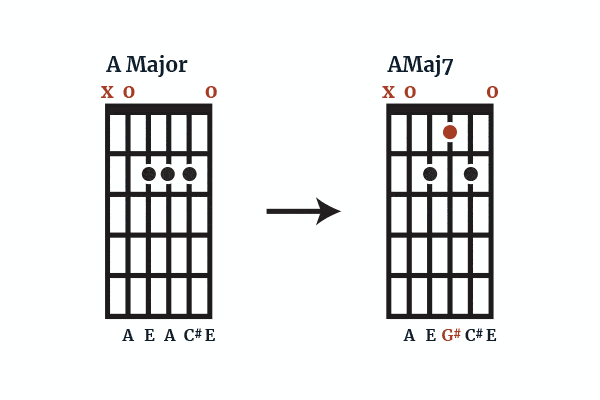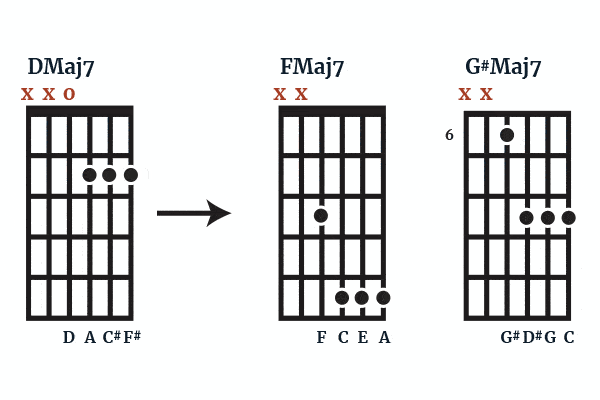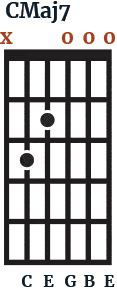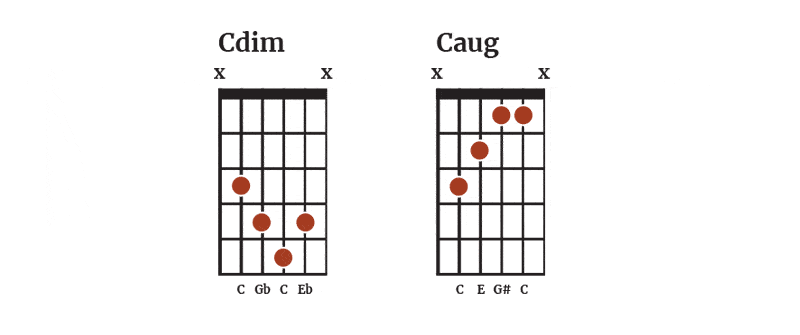In today’s article, we’re going to take a closer look at one of the four most common types of 7th chord, the Major 7 chord.
But, if you’re just looking for a quick overview: Major 7 chords are Major triads with an added Major 7th interval (11 semitones above the root, or one semitone below the root). Another way to build them is to simply add the 7th scale degree from the Major scale to an existing Major triad. The scale degree formula would therefore be 1, 3, 5, 7. Major 7 chords sound ethereal, dreamy, and lush, and in Major keys can be used as substitutions for I (tonic) and IV (sub-dominant) chords.
If you are looking for an overview of 7th chords in general, click here.
In the following article, I’m going to show you how to take advantage of Major 7 chords by demonstrating how they are constructed (so you can work out how to play Maj7 chords in any key, and then demonstrating how they are played including open position and moveable voicings, before finishing off with how to incorporate them into your playing.
But first, let’s take a listen to what a Major 7 chord sounds like compared to a Major chord.
What do Major 7th Chords sound like?
We’ll use the key of A Major for the examples in this article. Here’s a quick audio clip demonstrating an A Major triad in the open position followed by an A Major 7 chord, also in the open position.
As you can hear the Maj7th chord sounds more harmonically complex. Many people describe the sound of Major 7 chords as lush, dreamy, and slightly jazzy. You can hear Maj7 chords used to create a dreamy, lush soundscape in a song like ‘Lazarus’ by Steve Wilson (Porcupine Tree).
If we lowered the 7th to a minor 7th we’d have a dominant 7th chord which is often described as sounding more tense or urgent.
How to Build Maj7 Chords Using Intervals
All chords can be constructed using intervals or scale degrees. As we have already touched on above, Maj7 chords are essentially Major triads with an additional Major 7th interval from the root, spanning 11 semitones.
| Intervals | P1 | m2 | M2 | m3 | M3 | p4 | A4 | P5 | m6 | M6 | m7 | M7 | P8 |
| Semitones | 0 | 1 | 2 | 3 | 4 | 5 | 6 | 7 | 8 | 9 | 10 | 11 | 12 |
| Notes | A | A♯ | B | C | C♯ | D | D♯ | E | F | F♯ | G | G♯ | A |
As can be seen in the table above, if taking the Root (P1), Major 3rd (M3), Perfect 5th (P5), and Major 7th (M7) from A Major we are left with the notes: A, C#, E, and G#

If we were looking at the intervals relative to the individual notes of an A Maj7 chord we are simply stacking thirds by adding an additional Major third (4 semitones) from the fifth (E).
On the musical staff, this would look exactly as you might imagine ‘stacked thirds’ to appear.

How to Build Maj7 Chords using Scale Degrees
A Major
| 1 | 2 | 3 | 4 | 5 | 6 | 7 |
| A | B | C♯ | D | E | F♯ | G♯ |
The easiest way to build Major 7 chords on the guitar however is to reference scale degrees of the major scale. For example, the scale degree formula for Major chords is 1, 3, 5, and the scale degree formula for Maj7 chords is 1, 3, 5, 7
If you aren’t familiar with the Major scale, click here to learn all about them.
How to play Maj7 Chords
Below is an example voicing for an AMaj7 chord. Click here if you need to brush up on reading chord charts.

If you play A Maj with three fingers, the easiest way to transition to an AMaj7 chord is to lift both the index and middle fingers and then placing the middle finger on the 2nd fret of the D string (4th string) and your ring finger on the 1st fret of the G string (3rd string).
Doing this replaces the A with a G♯ which we can do and still have a complete AMaj7 chord as we already have the A (root) note on the open A string (5th string) included in the chord.
Below are some simple voicings for your main Maj7 chords in open position.



Barre Chords
Using moveable, barre and partial barre chords means we can play Maj7 chords all over the neck
Below, we’ll discuss three of the most common shapes, borrowed from our open position Major 7th chords above, starting with the AMaj7 shape.
AMaj7 shape

We can easily transition our open AMaj7 shape above into a barre chord by replacing the nut with the index finger. This is a particularly useful and comfortable shape to play across the neck.
DMaj7 Shape

Another popular voicing, that’s also easy to form is the DMaj7 partial barre chord shape. This is similar to an A barre shape except we are omitting the A string. You can simply barre the top 4 strings with the index finger.
Fmaj7 Shape

We can also use our FMaj7 shape by adding our pinky to the high E string one fret lower than the note fretted on the B string.
How to use Maj7 Chords on Guitar
Now that we understand how they are constructed and how to form both open position and moveable Major 7 chords, how do you go about using them musically?
You’ll mostly hear Major 7 chords in Jazz and R&B but they are also used across a wide range of genres. Major 7 chords function the same as Major chords. In Major keys, you can use Maj7 chords as substitute chords for I (tonic) and IV (subdominant) chords.
So, in the key of A, for example, this would mean substituting the tonic chord (AMaj) for AMaj7 and the subdominant Dmaj for Dmaj7.
| I | ii | iii | IV | V | vi | vii° |
| tonic | supertonic | mediant | subdominant | dominant | submediant | leading tone |
| Amaj/AMaj7 | Bmin | C♯min | Dmaj/DMaj7 | Emaj | F♯min | G♯dim |
When using Major 7th chords in your music, remember 7th chords are essentially just triads with an extra note added to make the chord more interesting. Keep this in mind and also experiment with different voicings, especially if playing accompanied.
Summary
Hopefully, after reading this article you now have an understanding of what Major 7th chords are, how they are constructed, and how to incorporate them into your playing. If new to 7th chords, start by learning your open position shapes and then taking some of those shapes including Amaj7, Dmaj7, and Fmaj7 in particular, and learning different positions and voicings all over the neck to add an extra dimension to your music.





![Open Chords V Barre Chords [And when to use them] 16 Open Chords V Barre Chords](https://theacousticguitarist.com/wp-content/uploads/2021/05/open-chords-v-barre-chords.gif)
![Guitar Chord Theory [Quick Guide] 17 Guitar Chord Theory](https://theacousticguitarist.com/wp-content/uploads/2020/01/guitar-chord-theory2.png)
